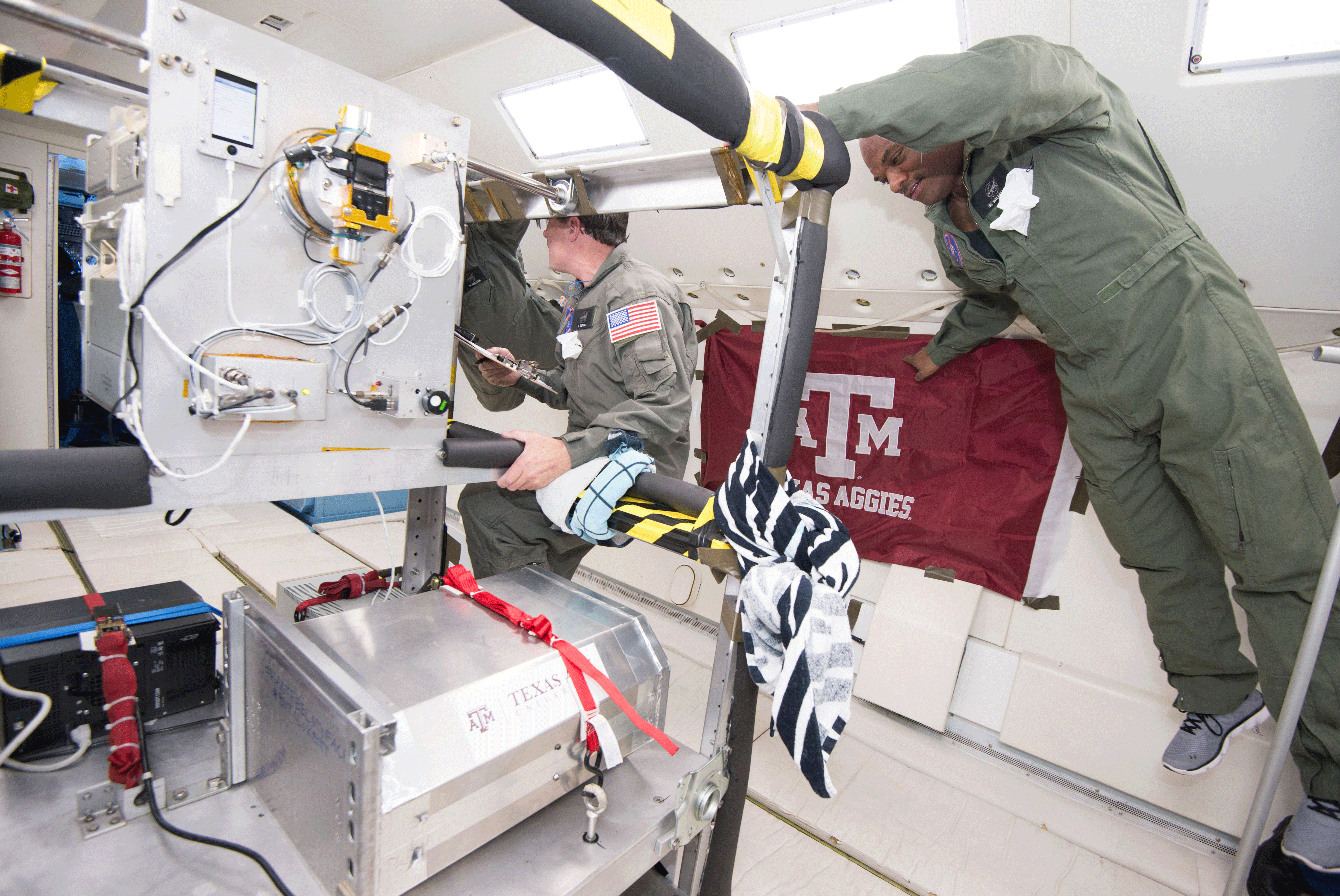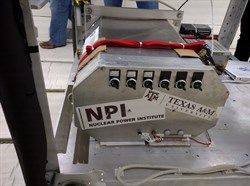
Dr. Cable Kurwitz and undergraduate researchers Aldo Sosa, Juan Duran and Victor Ibarra, has completed a successful flight-test program aboard NASA’s reduced gravity aircraft of the demonstration of a variable heat rejection (DoVR) system. The experiment served as a demonstration of several fluid handling technologies for an advanced radiator system to be used in future spacecraft.
Kurwitz is a Texas A&M Engineering Experiment Station (TEES) associate research engineer and senior lecturer with the Department of Nuclear Engineering at Texas A&M University. Duran and Ibarra are both nuclear engineering majors, while Sosa is an electrical engineering major.
According to Kurwitz the flight is a major step toward future suborbital testing aboard Virgin Galactic’s first research flight. Kurwitz, who is the director of the Interphase Transport Laboratory at Texas A&M, has been carrying out thermal fluid experiments related to this technology for over 25 years. The undergraduate student researchers assisting with this project are part of an undergraduate enrichment program sponsored by the Nuclear Power Institute (NPI). The program tasks students with engineering projects that are of interest to industry and government, provides them with mentorship opportunities and allows them to develop practical engineering experiences. According to Kurwitz, development of the DoVR system will allow future spacecraft to handle a wide variety of thermal loads and conditions.

“The DoVR system builds upon many previous technology programs to vary heat rejection from spacecraft radiators through the change in effective radiator area by modulating liquid between selected radiator lines and a gas-liquid separator,” Kurwitz said.
Kurwitz explains like all vehicles, spacecraft generate thermal energy from their onboard electronics, payloads and other sources in addition to absorbing it from external sources such as the sun and the Earth. On Earth, our machines can be cooled with air or liquid, but this is not possible in the vacuum of outer space. The DoVR technology builds upon current pumped liquid spacecraft radiators, but controls where the liquid in the radiator is allowed to flow using a set of valves, a gas-liquid separator and an ejector pump. This allows spacecraft to reject varying levels of waste heat to different sink temperatures preventing the spacecraft from overheating.
Kurwitz says the process of exchanging the liquid in the radiator with the gas in the separator in space is similar to filling an empty bucket with water from a water tank on Earth. As the tank is emptied out into the bucket, air will be displaced from the bucket and will fill the volume in the tank that once held water. While this is a simple process that occurs on Earth because of gravity, the DoVR technology will allow this to occur in a zero gravity setting. The gas liquid separator technology was developed at Texas A&M and has been licensed to Advanced Cooling Technologies Inc., in addition to being used on a space mission that is currently in orbit. The flight testing and suborbital testing that Kurwitz and his students participated in aims to test the exchange of fluids between the radiator and the separator in a zero gravity environment which until now has only been tested on Earth.
“It’s been demonstrated that experiments that fly on the aircraft first have a much higher probability of success when you go to suborbital or orbital testing because something unforeseen or that was assumed to work in a low gravity environment fails,” Kurwitz said. “Since most investigations involving thermal hydraulics are carried out under gravity on earth, the relationships that describe fluid flow are developed with the assumption that it is for Earth conditions. That doesn’t take into account the variety of gravity conditions we have to consider.”
However, another challenge Kurwitz and his students also have to account for are the many changing thermal conditions of space.
“Being able to change the radiator capability is very desirable because it allows us to have much more flexibility in the amount of power we have to reject and allows us to work in a variety of different cold and hot environments in space,” Kurwitz said. “The challenge becomes that traditionally we would build a big radiator to handle the high amount of energy we have to reject in the hot environment in low Earth orbit, but then the problem is that as we transit out to somewhere like Mars where we’re not rejecting as much energy and it’s much colder, it would essentially cause our spacecraft to freeze.”
Kurwitz and his group feel that with these tools the radiators onboard spacecraft will be able to operate more efficiently in different thermal environments.
“We’re essentially using a lot of technology that we have a lot of experience with in a space environment,” Kurwitz said. “So we have a high confidence that it will work and that they will be able to work for a long period of time repeatedly.”
